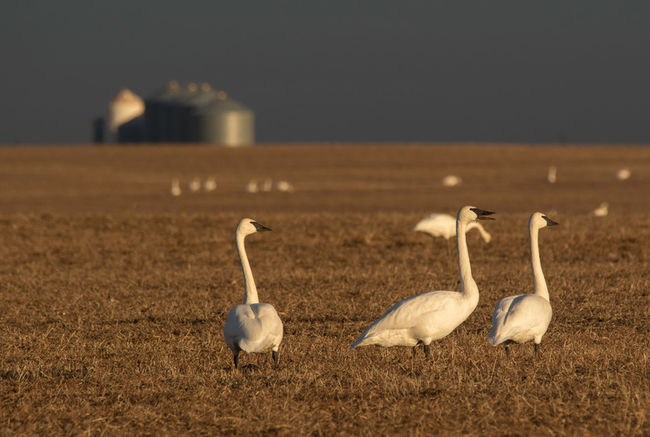Early bird gets the worm


The tundra swans are back in Lambton County, but much earlier than usual.
The birds generally arrive in early March on their migratory flight from Chesapeake Bay to the Canadian Arctic, but the first sighting of the birds landing in the former Thedford bog was reported Jan. 20.
Some of these early birds, so to speak, may not have flown all the way to their winter retreat in Chesapeake Bay, says Gwen Watson, of the Lambton Heritage Museum.
“Because of the warm weather maybe they stopped in Lake Erie, Lake Huron, and with the warm January weather they’re just kind of hanging around here,” Watson said, adding this is the earliest she’s seen them come back to the area.
A few years ago, some swans started landing near Grand Bend in the first week of February, “but this is the first time we’ve seen them in January,” she said.
An estimated 500 tundra swans are currently in the area, but Watson said the numbers vary as they fly in and out. It’s also hard to gauge due to the large area of land.
“It’s kind of hard to tell,” she said.
Although the swans’ arrival is a popular spring attraction, so far large groups of people haven’t noticed they’re already back.
“I’ve been out there the last couple of mornings and it’s just been me,” Watson said. “There’s probably not a lot of people looking for them this early.”
No matter when they arrive, the number of swans vary widely – some years the bog has seen just 50 and other times 15,000, she said.
“I’m hoping this is just the leading edge and the rest of the pack has yet to come,” she said. “It’s very unpredictable.”
The birds stop in Lambton County to rest and eat before continuing on the journey through Manitoba and Alberta on their way to the arctic. The goal is to be up north by May in order to nest and mate before making the return trip in the fall.
They’re attracted to the particular plot in Lambton Shores because it used to be a shallow lake, Watson said. The field floods in the spring, providing water along with leftover corn and beans from previous harvests.
Every year the Lambton Heritage Museum hosts the Return of the Swans festival to make the occasion.
As for this year’s edition – which will be the 33rd – it’s been set for March 11 to April 2 regardless of the local swan population at the time.
“Of course we’re hoping by then that we will still have swans,” Watson said. “I know it’s supposed to get colder and snowy again next month, so it wouldn’t surprise me at all that we do have swans here in March.”
If not, there are still swan displays and other attractions that museum-goers tend to enjoy, Watson said.
The festival usually draws between 1,000 and 1,500 people to the museum while a similar number view the swans from Greenway Road, just north of the facility.
During the same time frame, the museum is hosting the annual Paint Ontario art competition and sale. A new addition this year is a travelling exhibit – called Hands On Nature – from the Royal Ontario Museum.
Watching the swans from the road is free, but regular museum admission applies for the art show and swan displays. Admission is $5 for adults, $4 for seniors and students, and $3 for children.
@ObserverTerry
